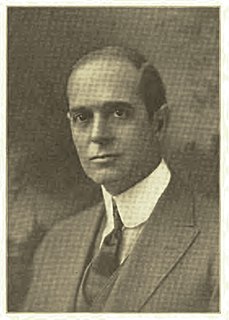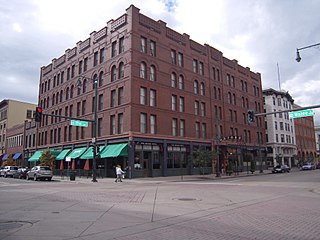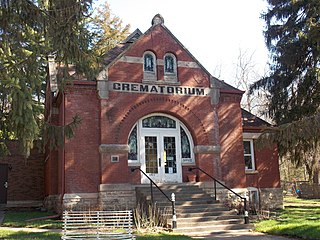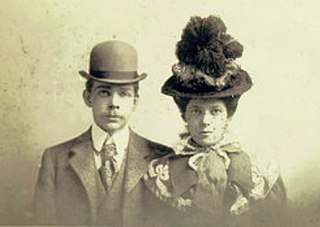
Fairmount Park is the largest municipal park in Philadelphia, Pennsylvania and the historic name for a group of parks located throughout the city. Fairmount Park consists of two park sections named East Park and West Park, divided by the Schuylkill River, with the two sections together totalling 2,052 acres (830 ha). Management of Fairmount Park and the entire citywide park system is overseen by Philadelphia Parks & Recreation, a city department created in 2010 from the merger of the Fairmount Park Commission and the Department of Recreation.

Humboldt Street Historic District, or Humboldt Island, is located west of Cheesman Park in Denver, Colorado on Humboldt Street between East Tenth and Twelfth Streets. It was the first residential district to be designated a historic district by the Denver Landmark Preservation Commission in 1972, and is listed as a historic district on the National Register of Historic Places.

The Stoiber-Reed-Humphreys Mansion is located within the Humboldt Street Historic District in Denver, Colorado. The district was listed on the National Register of Historic Places on December 29, 1978. The mansion is considered "the largest and most imposing residence in the district."

The Colorado Governor's Mansion, also known as the Cheesman-Boettcher Mansion, is a historic U.S. mansion in Denver, Colorado. It is located at 400 East 8th Avenue. On December 3, 1969, it was added to the U.S. National Register of Historic Places. It is open free-of-charge for scheduled tours, and also hosts special public events.

Bulkeley Wells, also spelled Buckeley Wells, was an American businessperson involved in Mining. Born in Chicago to businessman Samuel Edgar Wells and Marry Agnes Bulkeley, Wells was educated at Roxbury Latin School and at Harvard University. He married into the wealthy family of Colonel Thomas L. Livermore, to daughter Grace Livermore. He moved to Telluride, Colorado, and joined the executive board of the Telluride Mining Association, and headed up the San Miguel County Citizens' Alliance (SMCCA). He had a deputy sheriff's commission, and was captain of Troop A of the Colorado National Guard. He was also a Mason, and an Elk. Wells became president and manager of the Smuggler-Union Mining Company after the murder of Arthur L. Collins.

The Andrew Carnegie Mansion is a historic house located at 2 East 91st Street at Fifth Avenue in the Upper East Side of Manhattan, New York City, New York. Andrew Carnegie moved into his newly completed mansion in late 1902 and lived there until his death in 1919; his wife, Louise, continued to live there until her death in 1946. The building is now the Cooper-Hewitt, Smithsonian Design Museum, part of the Smithsonian Institution. The surrounding area, part of the larger Upper East Side neighborhood, has come to be called Carnegie Hill. The mansion was named a National Historic Landmark in 1966.

Riverside Cemetery, established in 1876, is Denver, Colorado's oldest operating cemetery. More than 67,000 people are buried there, including 1,000 veterans.

Cheesman Park is an urban park and neighborhood located in the City and County of Denver, Colorado, United States.

Lemon Hill is a Federal-style mansion in Fairmount Park, Philadelphia, built from 1799 to 1800 by Philadelphia merchant Henry Pratt. The house is named after the citrus fruits that Pratt cultivated on the property in the early 19th century.

Fairmount Cemetery in Denver, Colorado, was founded in 1890 and is Denver's second oldest operating cemetery after Riverside Cemetery. It was designed by German landscape architect Reinhard Schuetze. The cemetery was patterned after Mount Auburn Cemetery in Boston. The cemetery is 280 acres. The first year the cemetery opened over 4500 trees and shrubs were planted by Schuetze. The cemetery is the largest arboretum in the state.

The Oxford Hotel is a historic building in Denver, Colorado, which was designed by early Denver architect Frank Edbrooke, and built in 1891. It was listed on the National Register of Historic Places in 1979. The Cruise Room is a hotel bar with historic art deco interior, that was operated as an illicit speakeasy.
Edward Divine White Jr., FAIA, was an architect based in Denver, Colorado, whose forty-year practice focused on contemporary architecture and historic preservation. Along with his architectural practice, White was lifelong friend to Jack Kerouac from 1947 to Kerouac's death in 1969. The pair exchanged over 90 letters and postcards during that time.

The Davenport Crematorium is located in Fairmount Cemetery in the West End of Davenport, Iowa, United States. It was the first crematorium established in the state of Iowa and one of the oldest in the United States. The facility was listed on the National Register of Historic Places in 1983.

The Constantine Sneed House, also known as Windy Hill, is a historic mansion in Brentwood, Tennessee. It was one of four houses built by the Sneed family on the Old Smyrna Road.

Theodore Davis Boal, also known as Terry Boal, was an American army officer and architect. He entered into several partnerships over his career, the Boal and Harnois architectural firm in Denver, Colorado and a partnership with Ward Brown in Washington D.C. He designed a number of important mansions that are listed with the National Register of Historic Places. One of his important works, also an NRHP property, is the ancestral family estate, Boal Mansion.

The Solitude Mansion is a historic two-and-a-half story Federal-style mansion located in west Fairmount Park, Philadelphia, above the banks of the Schuylkill River on the grounds of the Philadelphia Zoo. The house was built sometime between 1784 and 1785, and historical records suggest that it was designed by its owner John Penn, grandson of William Penn, the founder of the city of Philadelphia and the state of Pennsylvania. The mansion is also referred to as The Solitude and The Solitude House, as well as the John Penn House and simply Solitude without the definite article. The name of the house was inspired by the Duke of Württemberg's much larger Castle Solitude outside Stuttgart, Germany. The Solitude is the only extant home of a Penn family member in the United States.
Walter Rice, also known as Walter L. Rice (1866–1930), was an American architect, inventor, and engineer. He made a career as an architect in Denver, Colorado, particularly for the design of apartment buildings. Several of his buildings are designated National Register of Historic Places. He patented inventions for automobiles.

Louise Sneed Hill was a society leader in Denver, Colorado in the 19th century. She was the wife of Crawford Hill and daughter-in-law of senator and mining executive Nathaniel P. Hill. She created the first list of socialites in Denver, called the Who's Who in Denver Society, now called the Blue Book. She entertained with lavish parties and card games for an elite group called the Sacred 36.

Crawford Hill was a businessman from Denver, Colorado, the president of a number of companies. He was commissioned a colonel and on the military staffs of Governors Albert McIntire and John Long Routt. Hill was director at the Colorado Museum of Natural History and the Young Women's Christian Association.



















